Special Collections
Bookbindings at Keble College – a book conservator’s vade mecum
By Jane Eagan ACR ICON, FIIC, Head Conservator, Oxford Conservation Consortium[i]
Keble College’s manuscript collection came to the college in the first 45 years after the college’s foundation. The principal benefactions were made by the Rev. Dr Henry Parry Liddon, the Rev. Charles Edward Brooks, and the Rev. Dr James Elwin Millard, who in addition to bound manuscripts, donated early printed books and rolls. The books donated reflect the ideals of the benefactors and founders of the college, and books of hours, missals, breviaries, lectionaries and ordinals predominate, as Parkes noted in his catalogue. However, the rich quality of the books, their often luxurious and unusual contemporary bindings speak not only to the desire to improve young minds, but also to the book as a desirable object, to the nineteenth-century bibliomania and passion for collecting, and the well connectedness of the men who gifted them to the college.
Keble MS Ethiopic 1 and 2
A Continuous Manuscript Tradition
These manuscripts caught my eye years ago as objects that hold and transmit information about the early multi-quire codex binding tradition that has disappeared from other countries and binding practices, yet persists to this day in Ethiopia and Eritrea.[ii] The Ethiopian/Eritrean scribal tradition is one of the last continuous manuscript traditions in the Christian world, and these two manuscripts from Keble’s collection show steps in the change from the roll to the codex in Late Antiquity. By their physical form, these manuscripts take us back in time nearly to the start of the history of the codex even though they were produced in the eighteenth and nineteenth centuries. The manuscripts are made of parchment bifolia (a folded piece of parchment, providing two leaves or four pages) nested together into quires then bound with a linked unsupported sewing, with wooden boards anchored to the text-block by the primary sewing thread. These relatively modern bindings of elegant simplicity preserve vestiges of much older binding practices that were replaced by technological developments and innovations in other traditions – this is what makes them so special.[iii]


Fig. 1 Oxford, Keble College, Ethiopic 1, left/upper board (left). A magico-religious text with symbols which may have protected against illness and misfortune. This manuscript is unusual in having a continuous parchment spine lining, the extensions of which are cut to permit the lining to be taken to the inner face of the boards (right).
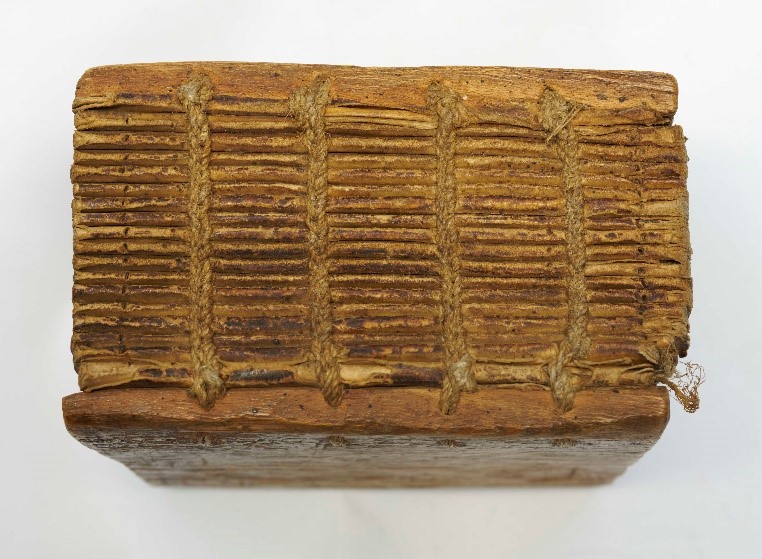
Fig. 2 Oxford, Keble College Ethiopic 2 (spine). A compact and functional binding with paired sewing stations, link-stitch (unsupported) sewing, and shaped wooden boards. The empty holes at head and tail are now redundant but would originally have been used for sewn/wound endbands at either end.
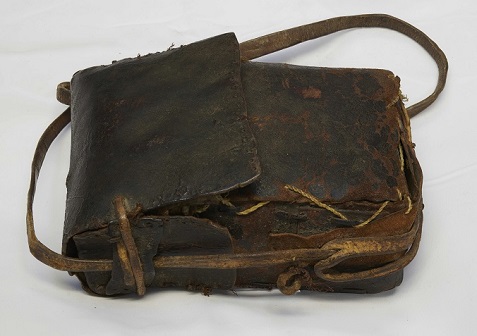
Fig. 3 The mahdar or two-piece leather book satchel for manuscript Ethiopic 2 with its telescopic cover (mulu mahdar), was used to carry the manuscript over the shoulder or for storage hung from a peg in a church or the house of the owner. The satchels are close fitting and the book is inserted vertically.
Keble MS Greek Roll 2
From Roll to Codex
By Late Antiquity, the codex had replaced the roll as the standard book form. Before then, the wooden wax tablet, single- and multi-gathering codices, and rolls of papyrus and parchment co-existed and overlapped in time until the multi-quired parchment codex replaced the other book forms. Keble MS Greek Roll 2, a twelfth-century Greek manuscript written in gold on parchment, is a reminder of these earlier book forms. The embellishment of letterforms with gold, or chrysographia meaning ‘writing in gold’ in Greek, can be made with either powdered gold mixed with a binder to produce an ink, or with gold leaf applied to a ground. In the case of MS Greek Roll 2 each letter has been written with a red ground onto which gold leaf has been applied then burnished to create a shine; the text of this Euchologion, or prayerbook used in the Eastern Orthodox liturgy, has truly been illuminated. It is fitting that St John Chrysostum’s words have been written in gold, as his name Chrysostum means ‘golden mouthed’ in Greek. This was a costly item to produce, and it is rare to find Greek text written in gold, and even rarer after the siege of Constantinople in 1204.[iv] The roll is made of sheep or goatskin membranes, with the final edge glued to a simple wooden batten.
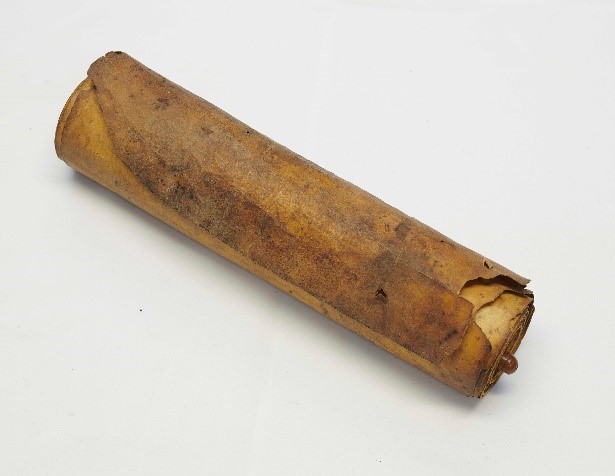
Fig. 4 Oxford, Keble College MS Greek Roll 2. The leading edge of the roll has ingrained dirt and rodent damage. The text is written on the whiter flesh side of the animal, although unusually there is writing on both sides.

Fig. 5 Oxford, Keble College MS Greek Roll 2 (detail). Transverse creases in the parchment due to rolling/unrolling can be seen which contribute to flaking and loss of the gold leaf.
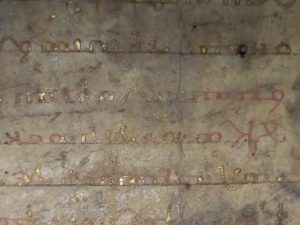
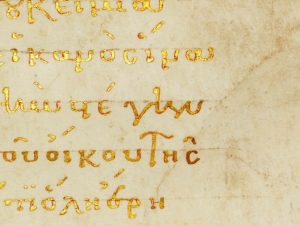
Fig. 6 Oxford, Keble College MS Greek Roll 2, two details of the text. On the left, from the worn and darkened leading edge, showing physical damage from rolling and the loss of gold leaf. On the right, an area in better condition, where the red bole ground layer can be seen beneath the gold leaf.
Binders Binding in Complexity
Millard 41
The oldest manuscript material in Keble’s special collections is not a complete work, but four seventh-century fragments used in the binding of a fifteenth-century printed copy on paper of Eusebius’ De evangelica preparatione (Venice, 1473), given to the college in 1894 by James Elwin Millard (Fig. 7). The fragments date to c. 785-821, and are part of a Gregorian sacramentary written for Arno, first bishop of Salzburg, contemporary of Alcuin of York, and close advisor to Charlemagne (Fig. 8).[v] Arno of Salzburg is credited with having introduced the Carolingian Renaissance into Bavaria, and assembled an impressive library of 150 manuscripts. The use of manuscript fragments by bookbinders is well documented and many works which have fallen out of use survive only where they have been reused by binders in the creation of new structures. Although this is an incunable printed in Italy, it is in a binding typical of German-speaking lands. Millard 41 has thick beech boards into which loosely twisted double cords have been laced and pegged. Unusually, small wooden wedges were used at the entry holes to trap and hold the cords before they were pegged finally at the exit holes (Fig. 9).[vi] There were paired fore-edge clasps, clasping on the upper cover in line with the ‘German rule’, while the English and Italians clasped on the lower board.[vii] The binder used ‘waste’ parchment, the seventh-century manuscript fragments to line the spine panels between the sewing supports, the extensions of these linings were adhered to the inner faces of the wooden boards, creating a strong board attachment. Strips of the sacramentary were folded around the first and last quires also adding to the mechanical strength of the structure. Books are often interesting because of the repairs made to them, and Millard 41 was repaired in 1968, when the spine covering leather was lifted to reattach the boards, and the recycled parchment fragments were taken out, guarded onto paper and resewn at the beginning of the manuscript (Fig. 9).[viii] This makes them more visible as both sides can be seen, but changes the structure and disturbs the evidence of the binding. Book conservators now attempt to stabilise rather than remove or alter structural evidence in this way. Luckily the 1968 repair work was noted on the new (lower) flyleaf of the binding (Fig.10).
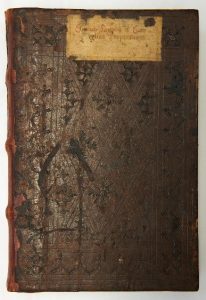

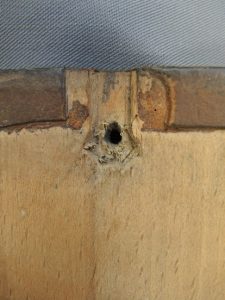
Fig. 7. The upper cover or outer face of left board decorated in a blind-tooled diaper pattern with stamped tools showing oak leaves and acorns (left). At the head (top) of the lower cover or outer face of the right board, a single hole can be seen where the chain staple was positioned, the manuscript having originally been stored horizontally and chained to a lectern desk (centre). The chain staple was relatively carefully let into a shaped recess in the wooden board (detail, far right). The early manuscript titling piece on the upper cover is also evidence of this early method of storage and use.
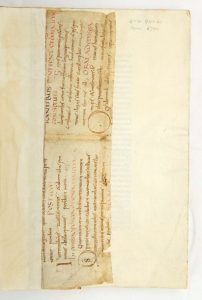
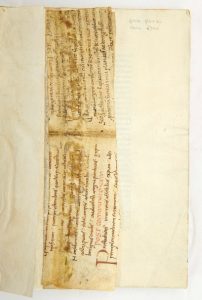
Fig. 8 frags. Fragment 1 recto (left), and 2 recto (right). These outside hook guards were cut horizontally from the open bifolium of the Sacramentary, turned vertically and folded around the first and last quires of Millard 41, and sewn through the fold. These fragments have been tipped onto paper guards and attached to the text-block.

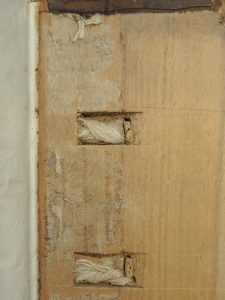
Fig. 9 Inner face of the lower/right board (left) and detail of lacing (right). The entry hole, where the twisted cords enter a shallow channel on the inner face of the board has been wedged with a small piece of wood, as has the exit hole, where the cords are brought to the outer face of the board and the ends cut off. Offset of ink and pigments from the panel spine linings can be seen between the sewing supports. The laced-in structural endband core can be seen just below the turn in leather at the head.
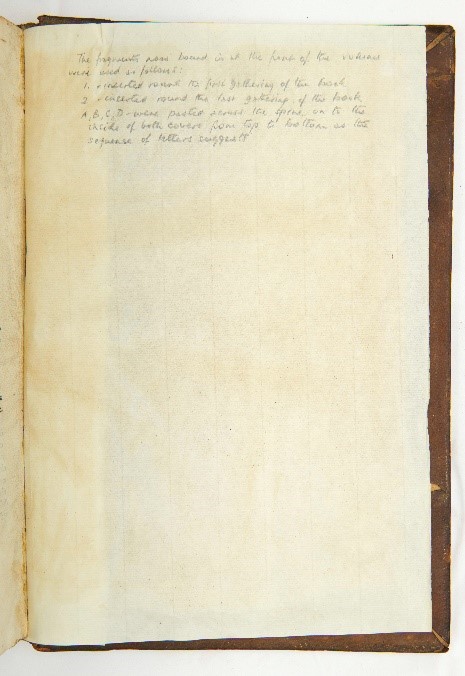
Fig. 10. Note giving details of the original location of the fragments within the fifteenth-century binding, before the 1968 reback treatment.
A Restoration Treasure
Brooke 263
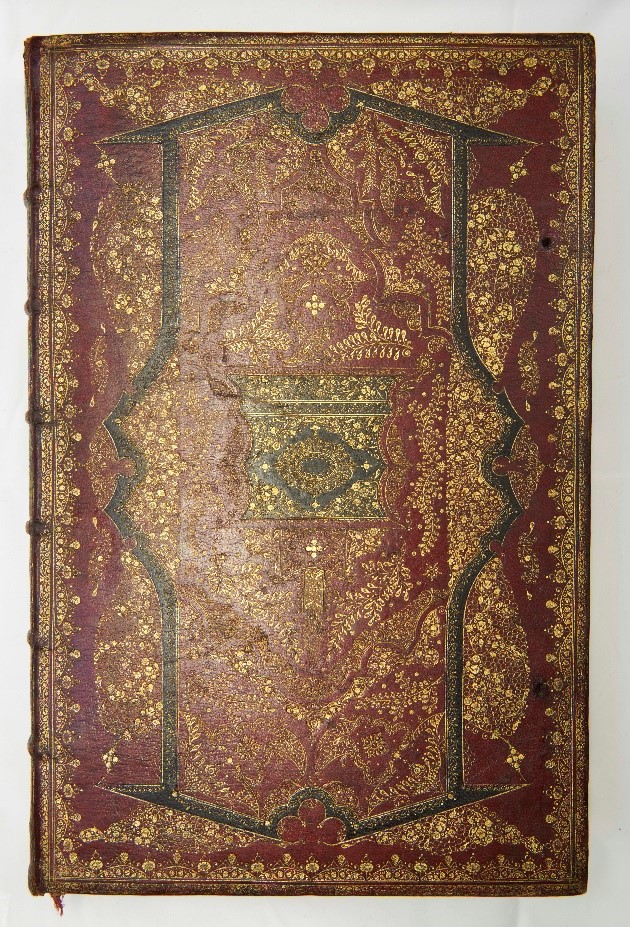

Fig. 11. Book of Common Prayer, 1662. Left/upper board (left), Right/lower board (right).
Keble has the first edition of the Book of Common Prayer, printed in 1662 in London by John Bill and Christopher Barker, printers to the King. The Prayer Book is the traditional service book of the Church of England, compiled in the sixteenth century and modified in 1662. Keble’s copy was given to the college by Rev. Canon C.E. Brooke in 1911, Brooke having received it in 1908 on the death of his brother, Sir Thomas Brooke, a woollen cloth manufacturer and major collector of books and manuscripts. Thomas Brooke amassed a library valued at £25,000 during his lifetime and bequeathed part of his collection of religious works including 38 manuscripts to his brother, C.E. Brooke, who in turn left them to Keble.[ix] Keble’s fine copy is in a contemporary binding in the so called ‘cottage roof’ style, the central panel having a design outlined with black goatskin onlays in the shape at top and bottom of a roof.[x] The covering of full red goatskin is sumptuously decorated with dense and highly ornamental gold tooling with curls, leaves, and floral motifs. This beautiful and costly binding is closely related to similar works attributed to the workshop of Royal Binder Samuel Mearne, and while we can’t be certain that Keble’s binding is by Mearne, given that his contemporaries and apprentice/successor Robert Steel created bindings in the same cottage-roof design and using the same decorative vocabulary, Keble is fortunate in having a beautiful example of the ‘golden age’ of English bookbinding and a true ‘Restoration treasure’.[xi]

Fig. 12. Frontispiece engraved by David Loggan, who moved from London to Oxford in 1665, where he was appointed engraver to the University of Oxford and produced his famous work Oxonia Illustrata in 1675.
A Book Within a Book
Crossings: A Fairy Play by Walter de la Mare
Inside this relatively plain-looking stiffboard parchment binding, there are two lovely surprises. First, the book contains the original drawings by Randolph Schwabe which illustrate Walter de la Mare’s Crossings: A Fairy Play.

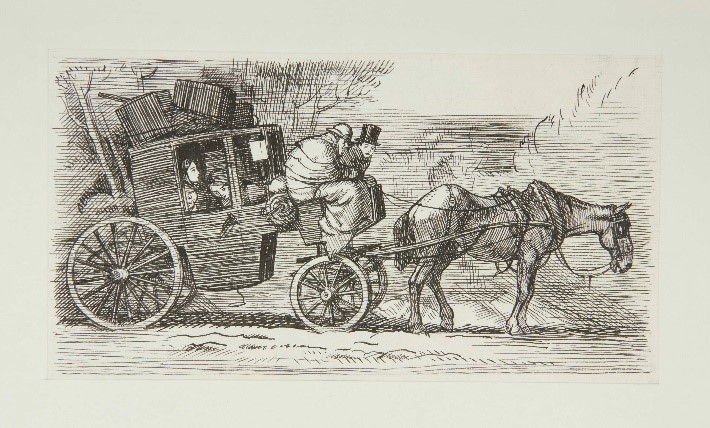
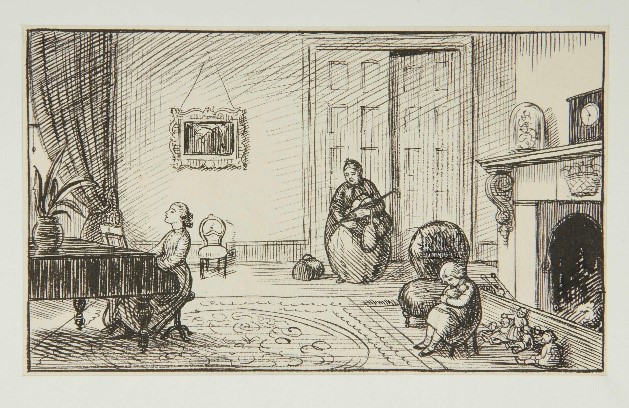
Fig. 13. Schwabe’s illustrations for Crossings in bold pen and black ink.
Toward the back of the volume is the second surprise; inside a marbled-paper-lined recess, is the printed edition of Crossings, also bound in creamy white parchment with gold-tooled holly and ivy sprigs in the corners of the covers.
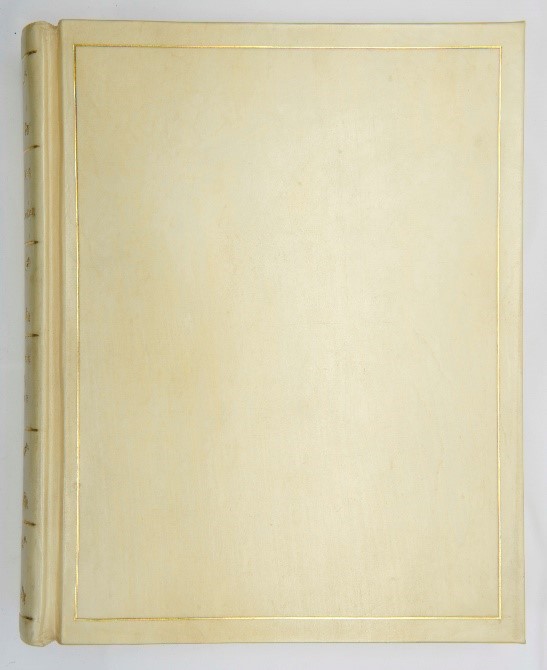
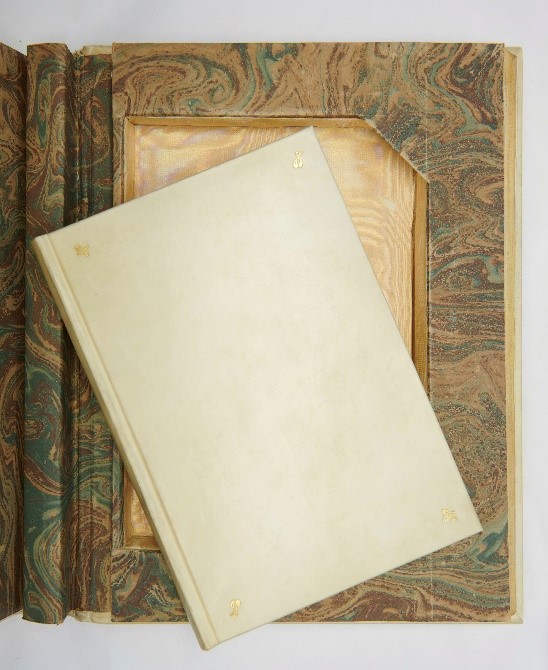
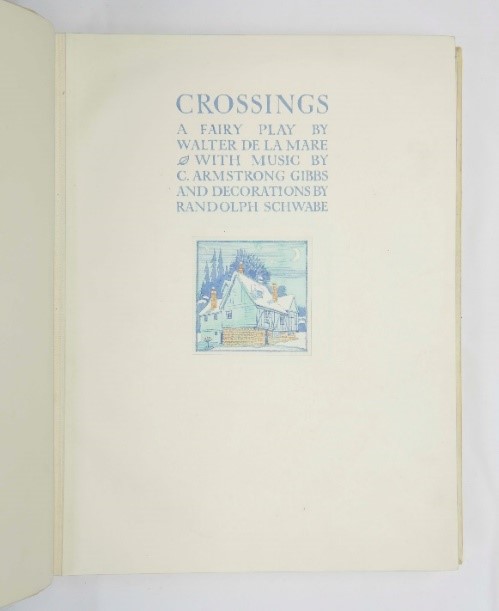
Fig. 14. Crossings (left/upper board), and the book within a book (right).
The play Crossings tells the story of four children left alone in a country house for a fortnight, and was published in 1921 by the Beaumont Press, a private press specialising in new poetry and prose.[xii] Music for the play was written by C. Armstrong Gibbs, who studied under Vaughan Williams and Adrian Boult, the latter conducting Gibbs’ music in a charity production of the play over two nights in November 1925 at the Lyric Theatre, Hammersmith, with Ellen Terry coming out of retirement to take part.[xiii] Randolph Schwabe, a draughtsman, printmaker, and official war artist for both world wars contributed the cover design, title page and 15 other decorations.[xiv]
Keble’s copy is an extra copy outside the regular edition, printed especially for E. J. Evans, Esq. and signed by de la Mare, Cyril Beaumont, C.A. Gibbs, and R. Schwabe.
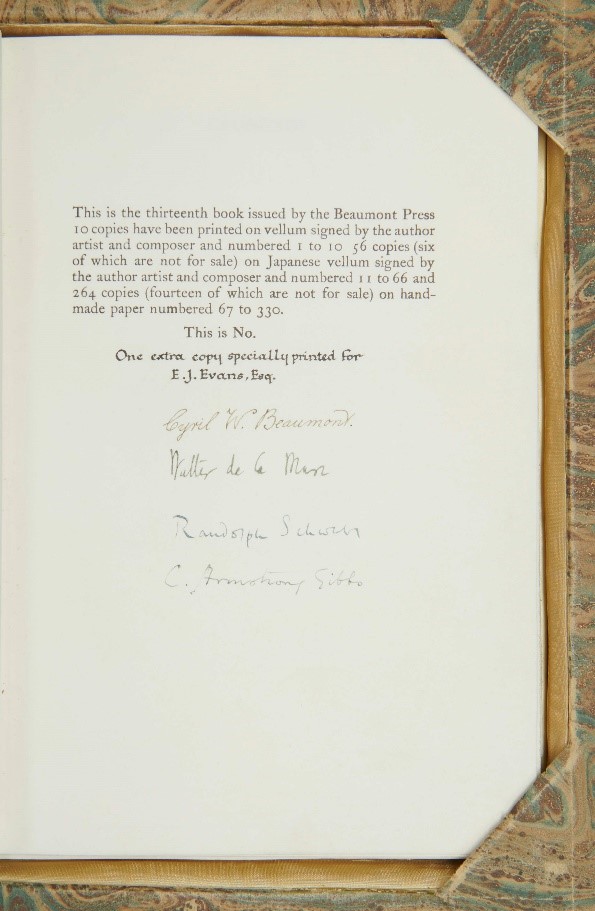
Fig. 15 Signed by the author, artist, composer, as well as the publisher.
[i] The Oxford Conservation Consortium carries out preservation activities and conservation treatments in Keble’s special collections. For more information about collection care/OCC, see: www.chantrylibrary.org I am grateful to Yvonne Murphy, and Colin Dunn for their assistance and photography.
[ii] For more on Ethiopic and Eritrean books, see Gnisci, J. ed., Treasures of Ethiopia and Eritrea in the Bodleian Library, Oxford (Oxford University: Ioannou Centre, 2019).
[iii] For a fascinating study of the development of the codex and its relationship to other artisan-crafted objects, see Boudalis, Georgios, The Codex and Crafts in Late Antiquity (New York, Bard Graduate Center, 2018).
[iv] Nigel Wilson, private communication.
[v] For Arno of Salzburg and Charlemagne’s court circle, see A. Firey, A Contrite Heart; Prosecution and Redemption in the Carolingian Empire (Leiden/Boston: Brill, 2009) pp. 187-194.
[vi] Szirmai, J.A., The Archaeology of Medieval Bookbinding (Aldershot/Brookfield USA: Ashgate, 1999) p.185, Fig. 9.6, shows a similarly loosely twisted ‘cord’.
[vii] Szirmai, J.A., Archaeology of Medieval Bookbinding, p. 254.
[viii] Eagan, J., ‘Fit For a king: Evidence of the refurbishment of a group of medieval manuscripts for the library of Henry VIII’, Care and Conservation of Manuscripts 13 (Copenhagen: Museum Tusculanum Press, 2012).
[ix] Barber, B., ‘Working the “The Cause of Bibliomania Throughout the World”: Sir Thomas Brooke (1830-1908)’, URL: https://www.tandfonline.com/doi/full/10.1080/00844276.2018.1465684 accessed 24 Aug 2020.
[x] Onlays are pieces of thin leather usually in a contrasting colour that are adhered to the surface of the primary covering material for decorative purposes. For this and more information about terminology for describing bindings, please see the Ligature Language of Bindings website: https://www.ligatus.org.uk/lob/
[xi] The literature on decorative bookbindings of the Restoration period is considerable, a good starting point is: Foot, M.M., ‘The British Bindings in the Henry Davis Gift’, The British Library Journal v.3/2 (1977) 114-128. URL: http://www.jstor.com/stable/42554046, accessed 24 Aug 2020.
[xii] For more on the Beaumont Press, see: Suarez, M. and H.R. Woudhysen, eds., Oxford Companion to the Book, URL: https://www.oxfordreference.com/view/10.1093/acref/9780198606536.001.0001/acref-9780198606536-e-0464 Accessed 24 Aug 2020.
[xiii] URL: http://www.musicweb-international.com/GibbsCA/ Accessed 24 Aug 2020.
[xiv] URL: https://www.oxforddnb.com/view/10.1093/ref:odnb/9780198614128.001.0001/odnb-9780198614128-e-35978 Accessed 24 Aug 2020.
